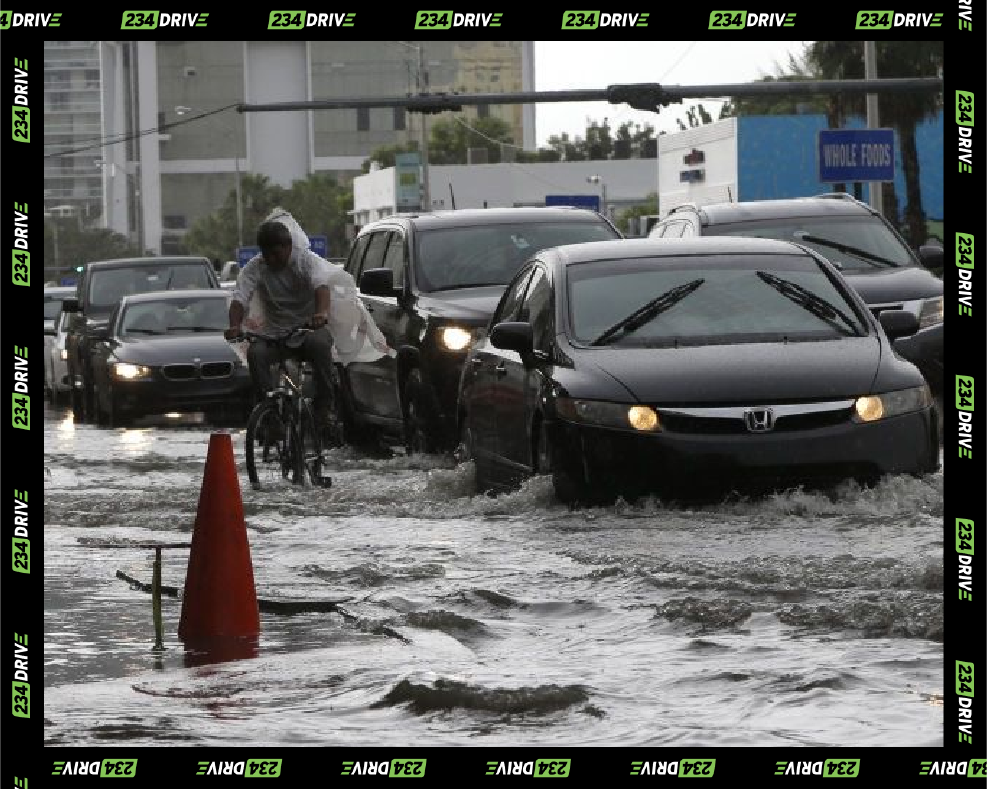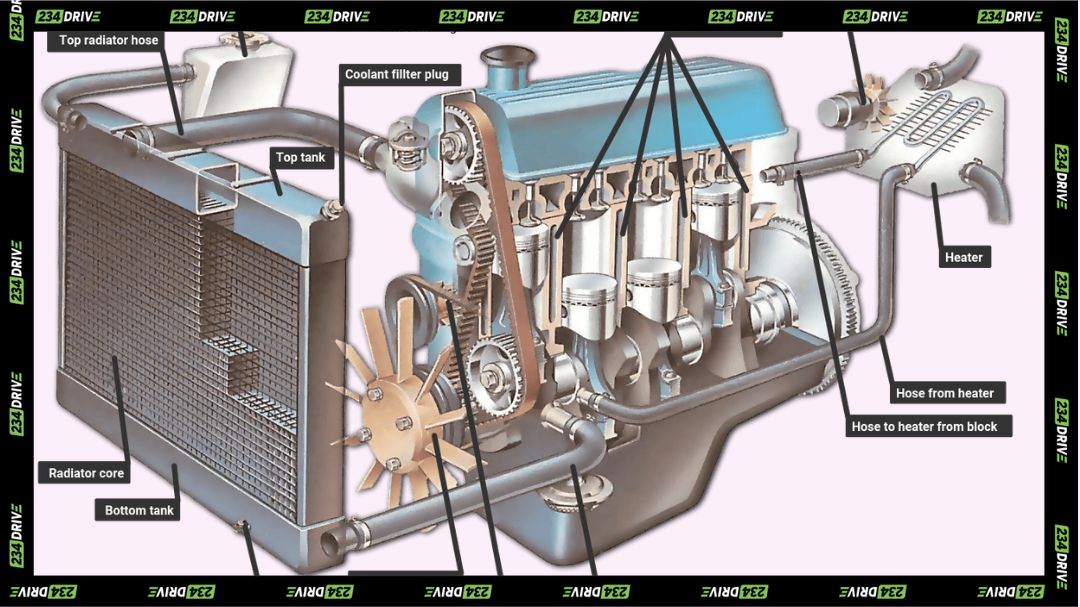Do you have friends who use a floater every time they visit the pool because they can’t swim and are at risk of drowning?
If there’s something peculiar about the rainy season in Nigeria, it’s the most spoken-about and dreaded “seven days rain” — where the clouds release water for seven days nonstop. Aside from the thunder and breeze that accompany it, floods inevitably follow. Commuters now have to navigate through these floods to reach their destinations, putting their cars’ swimming abilities to the test.
The rainy season can significantly impact cars, leading to mechanical and electrical issues, structural damage, and safety concerns. Water entering the engine can cause hydrostatic lock, while moisture can short-circuit electrical systems and even fry the ECU (also known as the brainbox). Wet brakes reduce stopping efficiency. Prolonged exposure to water accelerates rust and corrosion, damages interiors, and contaminates essential fluids like engine oil and brake fluid. Reduced traction on wet roads increases the risk of skidding and accidents, and visibility is often impaired by heavy rain. The problems seem unending.
In this article we will delve into the challenges cars face during the floods. From the daunting specter of performance issues to the risk of breakdowns, we explore the diverse damages water can wreak upon vehicles. We shine a light on which cars struggle more with water, offering insights that can help you navigate these potential pitfalls. Moreover, we provide practical tips on preparing your vehicle ahead of the rainy season, empowering you to safeguard your car against the unforgiving forces of nature.
Cars face numerous challenges when navigating through floods, often leading to severe mechanical and electrical issues. One primary reason is the risk of water entering the engine through the air intake, causing hydrostatic lock, which can seize the engine and result in extensive damage. Electrical systems are particularly vulnerable; moisture can short-circuit critical components like the battery, starter motor, and alternator, rendering the car inoperable. The brake system’s effectiveness is also compromised as water on the brake pads and rotors can significantly reduce braking efficiency, increasing stopping distances and the likelihood of accidents.
Additionally, the car’s traction on wet and slippery roads is diminished, heightening the risk of skidding and losing control. These factors collectively make it exceedingly difficult for cars to perform well in flood conditions, often leading to costly repairs and dangerous driving situations.
Someone should charge Fela for perjury—what do you mean water doesn’t have an enemy? It’s clear that the opposite is true. Water inflicts a variety of damages on cars, especially when they are exposed to floods. The most prevalent issues are corrosion and rusting of metal parts, which weakens the vehicle’s structural integrity and leads to costly repairs. The transmission system is also at risk; water infiltration can degrade the transmission fluid, causing poor gear shifting and potential system failure. Inside the car, water can wreak havoc on the upholstery, soaking seats and carpets, and leading to unpleasant odors and mold growth.
Electronic components, such as the infotainment system and dashboard instruments, are particularly susceptible to water damage, often resulting in malfunctions or complete failure. Additionally, essential fluids like engine oil, coolant, and brake fluid can become contaminated with water, reducing their effectiveness and potentially causing serious engine or brake system issues. These damages highlight the critical need for vigilance and protective measures during the rainy season to preserve the functionality and safety of vehicles.
Do you have friends who use a floater every time they visit the pool because they can’t swim and are at risk of drowning? Well, I do—not one, not two but thousands0. In Fact because of their number, I classify them as “non-swimmers.” These vehicles are particularly prone to water damage during the rainy season due to their inability to handle flooding effectively.
Sedans and Low Clearance Vehicles
These cars are at a greater risk of water damage primarily because of their low ground clearance. Normally the low ground clearance serve a form of balance for the car during serving and high speed and also because the air close to the ground is color the car are made low so the engine can cool.The lower the clearance, the easier it is for water to enter critical components like the engine and exhaust system, leading to severe mechanical issues.
Older Models with Less Advanced Sealing and Protection
Vehicles from earlier generations often lack the advanced sealing technologies found in modern cars. These older models are more susceptible to water ingress, which can cause rust, corrosion, and damage to electrical systems. Their outdated engineering makes them less resilient in flood conditions.
Cars with Electric Power Steering
Most new vehicles come with electric power steering, which is more efficient and reliable than traditional hydraulic systems. However, these systems are vulnerable to water damage. The electric components, including sensors and the control unit, can be severely affected if water penetrates the system, leading to steering issues and potential safety hazards.
Electric Cars
Special Considerations and Risks: Remember the year in Nigeria when there were deaths caused by the famous boiling ring incident? This underscores the fact that water and electricity don’t mix well. While electric cars are becoming more common, they pose unique challenges in flood conditions. The high-voltage batteries and electrical systems are particularly vulnerable to water damage, which can lead to catastrophic failures and even safety hazards. Special care must be taken to ensure these vehicles are protected from water exposure.
While it may look like SUVs should perform well in floods because of their ground clearance, some big boys still struggle. Notably, the Range Rover Velar and Venza are examples of SUVs that cannot swim effectively. Despite their high ground clearance, these models often lack the necessary sealing and protection against water ingress, making them vulnerable to water damage. This susceptibility can lead to issues such as electrical failures, interior flooding, and compromised mechanical components.
On the other hand, I have some friends who, as soon as we arrive at the pool, are already in their swimsuits and doing backstrokes in the water before you can say ‘Jack Robinson.’ I call them ‘swimmers’.
Certain cars are designed to perform reliably even in flood conditions. These vehicles typically include SUVs and trucks with higher ground clearance, which prevents water from easily entering critical components like the engine and exhaust system. They often feature advanced sealing technologies that protect the electrical systems and engine from water ingress. Some models are equipped with snorkel systems, which elevate the air intake to avoid water entry, and have reinforced underbodies to resist rust and corrosion. Additionally, all-wheel or four-wheel drive capabilities enhance their traction and stability on slippery, waterlogged roads. These features collectively enable these vehicles to navigate through floodwaters more effectively, providing greater safety and reliability during the rainy season. Examples of such vehicles include the Toyota Land Cruiser, Jeep Wrangler, Humvee, and Ford F-150 Raptor.
Proper preparation and maintenance are crucial for safeguarding your car during the rainy season . Here are key steps to ensure your vehicle is ready to handle wet conditions:
- Check and Replace Worn-Out Wipers and Tires: Good visibility is essential during heavy rains. Ensure your windshield wipers are in excellent condition and replace them if they show signs of wear. Similarly, inspect your tires for adequate tread depth and replace any that are worn out to maintain optimal traction on slippery roads.
- Ensure All Seals and Gaskets Are Intact and Functional: Water can seep into your car through damaged or worn seals and gaskets, leading to potential electrical and interior damage. Carefully inspect all door seals, window seals, and any other gaskets for signs of wear or damage, and replace them as necessary to prevent water ingress.
- Test the Battery and Electrical Connections: The rainy season can be particularly harsh on your car’s electrical system. Test your battery to ensure it is fully charged and in good condition. Additionally, check all electrical connections for signs of corrosion or damage and ensure they are secure. This can help prevent unexpected electrical failures when driving in wet conditions.
- Installing Water-Resistant Spark Plugs and Ignition Systems: Water-resistant spark plugs and ignition systems are designed to withstand moisture and prevent engine misfires. Upgrading to these components can improve your car’s reliability and performance in wet conditions, reducing the risk of breakdowns caused by water exposure.
- Using Weather-Resistant Floor Mats and Seat Covers: Protect your car’s interior from water damage by using weather-resistant floor mats and seat covers. These accessories are designed to repel water, making them easier to clean and preventing moisture from seeping into the car’s upholstery. This can help avoid mold growth and unpleasant odors inside the vehicle.
- Applying Rust-Proof Coatings to Vulnerable Parts: Rust-proof coatings provide an extra layer of protection against corrosion. Apply these coatings to the undercarriage, wheel wells, and other metal parts that are most exposed to water and road salt. This preventive measure can extend the lifespan of your car’s components and maintain its structural integrity.
- Knowing Your Car’s Wading Depth and Driving Techniques in Floods: Just like the warnings in pools, “It’s deeper than it looks,” it’s crucial to familiarize yourself with your car’s wading depth—the maximum depth of water it can safely drive through. Exceeding this limit can lead to engine and electrical damage. Learn and practice safe driving techniques in floods, such as driving slowly and steadily through water, avoiding large puddles, and not restarting the engine if the car stalls in deep water. Being informed and cautious can prevent severe damage and ensure your safety.
- Not Taking It Out at All: Sometimes the best safety tip is not to swim at all. Some cars are best left in the garage during the rainy season because even the slightest contact with water can cause damage. To avoid headaches and unexpected expenses, consider taking an Uber or another form of transportation during the rainy season.
Taking these pre-season inspection and maintenance steps can significantly reduce the risk of water-related issues, ensuring your vehicle remains reliable and safe throughout the rainy season.
The rainy season brings significant challenges for cars, including mechanical issues like hydrostatic lock, electrical failures, reduced braking efficiency, and common damages such as corrosion, transmission problems, and interior water damage. Low clearance sedans, older models, and electric cars are particularly vulnerable. To mitigate these risks, it’s essential to conduct pre-season inspections, maintain wipers, tires, seals, and electrical systems, and consider upgrades like water-resistant components and rust-proof coatings. Additionally, knowing safe driving techniques in floods can prevent breakdowns and extensive damage, ensuring your car remains reliable and safe throughout the wet season.










